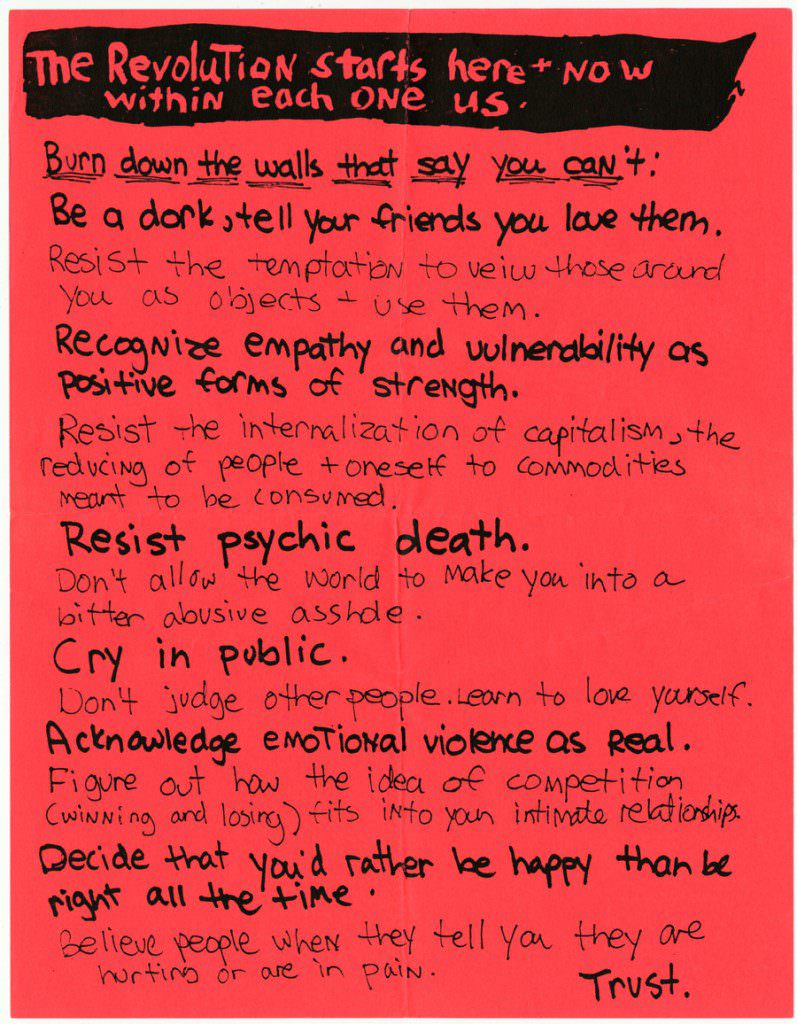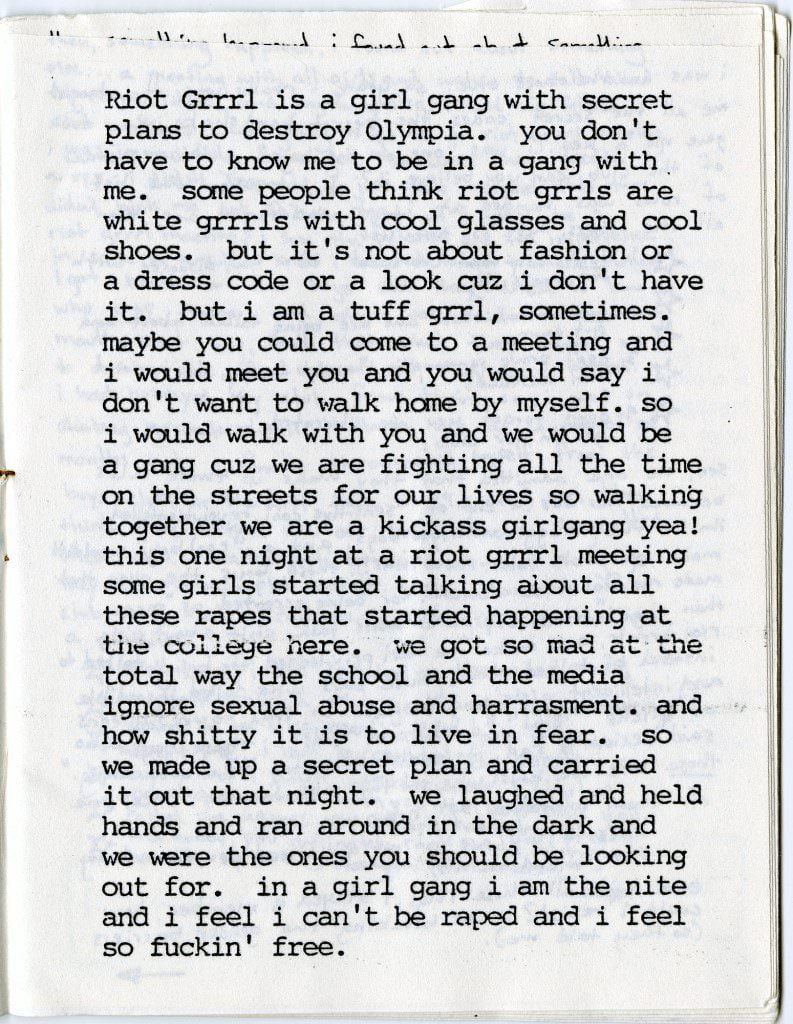“Riot Grrrl is the gateway drug that girls use to find feminist history.” —Kathleen Hanna, musician
Riot Grrrl was an underground feminist punk rock movement that began in the early 1990s. Twenty years after its peak, some might be familiar with its general ethos but its true legacy is a revision of feminism, a fuck-your-girl-hating, lipstick wearing, violence resisting, grrrl empowerment that gave voice to a generation of women that still reverberates.
Published by The Feminist Press, The Riot Grrrl Collection is edited by NYU Fales Library Senior Archivist Lisa Darms, who started the archive with initial papers donated by Kathleen Hanna and Johanna Fatemen (of the bands Bikini Kill and Le Tigre). Thanks to Darms, the Fales Library Downtown Collection now holds the entire Riot Grrrl archive, available to the public.
The Riot Grrrl Collection is more of an art book than an anthology, the collection comprises reproductions of manifestoes, essays, reviews, fiction, lyrics, drawings and collage art from zines including “Girl Germs,” “Chainsaw,” “Jigsaw,” and, of course, “Riot Grrrl”. There are punk singers (Corin Tucker, Allison Wolfe) and filmmakers (Sadie Benning, Miranda July), term papers and erotic musings.
In a sense, these are time capsules of a moment just before the Internet changed the way we communicate. The zines were purposely raw and retro: handwritten or typed, physically cut and pasted instead of made with then-available desktop publishing programs. These were semi-private communications, not processed, produced or prettied up product.
As the enthusiastic and illuminating introduction attempts to explain, Riot Grrrl was too many things to too many people—reclaiming body image, queer liberation, anti-establishment, anti-patriarchy—that it’s impossible to articulate as one single message. Without muddying the waters, Darms allows the collection to speak for itself.

This flyer, a pre–Riot Grrrl “manifesto”, is the first image in the book. Image credit – The Paris Review
More than 20 years after the Riot Grrrl zine movement, the term “feminist” remains loaded in our culture. As much as mainstream culture downplays the need for feminists, we’re living in a world where The New York Times’ first female executive editor is fired for challenging gender roles and pay equality. With so many contradictions and confusions, it’s a perfect moment to revisit the post-feminist movement, and The Riot Grrrl Collection fills the need in spectacular fashion.
The collection is a document of a moment, 1990-97, but it doesn’t feel steeped in nostalgia. Decades later, slogans like “Stop the j-word jealousy from killing girl love” strike me as being as vital for college students. Indeed, staying underground may have preserved these creations’ life force. Young women (and men) have found their way to feminism through Riot Grrrl.
Also Read: Eight Best Feminist Comics Of Tatsuya Ishida
Against the backdrop of the culture wars and before the rise of the internet or desktop publishing, the zine and music culture of the Riot Grrrl movement empowered young women across the country to speak out against sexism and oppression, creating a powerful new force of liberation and unity within and outside of the women’s movement. While feminist bands like Bikini Kill and Bratmobile fought for their place in a male-dominated punk scene, their members and fans developed an extensive DIY network of activism and support.
“This is about making new meanings of what it is to be cool,” Tobi Vail writes in Bikini Kill. “Embrace subjectivity as the only reality there is.”

Becca Albee the author of this page, who (like many riot grrrls) identified with a fifties girl-gang trope repurposed for feminist vigilantism.
Image credit – The Paris Review
The zines and their ephemera, photographed from the personal collections of original zine writers and movement members, have a charisma you must hold the book to understand. I found it impossible to simply flip through the book. Your eye catches a catch of a bombshell holding a gun, or a lightning bolt from the heart phrase in Courier font, and you’re drawn in. The strange articles and missives read like lyric poetry, exploring what feminism and friendship and sexuality and citizenship and music and art and family and identity mean.
By focusing on a relatively short era with a limited number of participants. The Riot Grrrl Collection runs the risk of being nostalgic. If Darms had commissioned a number of essays to surround the preserved zines and attempt to bring them into a 21st century context, this would be a much different book—interesting to some, but more convoluted and less accessible. Resisting the temptation to explain what Riot Grrrl was and trusting the material to speak for itself allows for a greater range of interpretation by the reader.
“Forget Andy Warhol and everyone being famous for 15 minutes. Because of riot grrrl we have new, exciting political movements every 15 minutes.” –Vaginal Davis, performance artist
The Riot Grrrl Collection is exactly the book I wish had been in my hands when I left for college. The frustration, defiance, and humour are universal, and the reminder to defy sexism hasn’t aged a day. There’s something about telling the patriarchy to fuck off in Sharpie that just feels more fun and subversive than a Binders Full of Women Tumblr. The precious photocopied art inspires you to be more creative, to be more dangerous.The book may have come to me in my early twenties, but not too late to rattle my heart and become my new go-to gift for every grrrl I know.
Featured Image Credit: MQLTV
Author’s note: I mourn missing out on a movement with the slogan “Encouragement in the face of insecurity.” I wanted to find my own way to be a part of it, somehow again, with different tools but all the bravery, honesty, and heart. To resist apologising for telling a story, for accepting ugliness and beauty on my own terms. To be a better version of whatever complicated woman I decide to be.
About the author(s)
Journalism student by day, insomniac (induced by the amount of knowledge in this world) by night.




